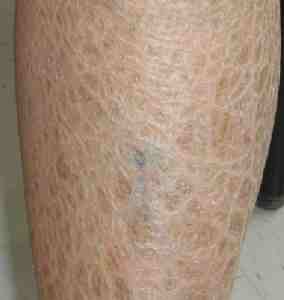

MedFriendly®


Ichthyosis Vulgaris
Ichthyosis vulgaris is an inherited skin condition
characterized by an excessive build up of dry,
rectangle-shaped scales, mostly on the legs. Signs and
symptoms vary in severity from mild cosmetic problems
to painful, bloody cracking of the skin that can become
infected if not treated. The condition is diagnosed by
skin doctors after seeing its very characteristic scaly
appearance.
Treatment of ichthyosis vulgaris involves adding
moisture to the skin and reducing the number of scales.
This can be achieved by applying certain types of
medicines to the skin such as alpha-hydroxy acids.
Ichyhyosis vulgaris.
FEATURED BOOK: The Simple, All-Natural Program for Clear, Calm, Happy Skin
Alpha-hydroxy acids are acids that come from fruit and milk sugars. They have been used
for centuries for skin rejuvenation. The most often used alpha-hydroxy acids are glycolic
acid and lactic acid because they have a special ability to enter the pores of the skin.
Effective moisturizer creams include those that contain petrolatum (a type of petroleum)
and urea. Urea is a chemical compound that helps moisturize the skin. Doctors typically
suggests that moisturizers be applied to the skin immediately after bathing so that they
enter the skin better. Ichthyosis vulgaris is also known as hyperkeratosis congenita and
ichthyosis simplex. Ichthyosis vulgaris comes from the Greek word "ichthys" meaning
"fish," the Greek word "osis" meaning "condition," and the Latin word "vulgaris" meaning
"a crowd" Put the words together and you get "a crowd (of) fish conditioning."
"Where Medical Information is Easy to Understand"™















